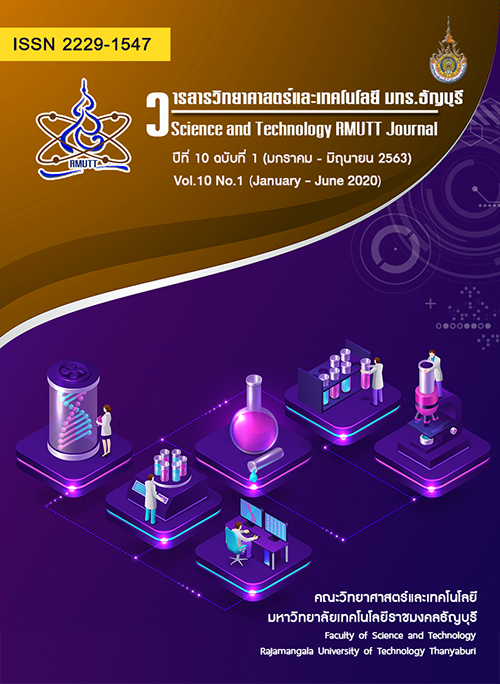Comet assay of healthy elderly people in Thai people in Tambon Lak Hok population at Pathumthani province by Lucia program
Main Article Content
Abstract
The Comet assay is a sensitive and rapid method for DNA damage in individual cells. It has found wide acceptance in epidemiological and bio monitoring studies for determination of DNA damage resulting from lifestyle, occupational and environment exposure. However, there is no information regarding the influence of the Thai people in Tambon Lak Hok population at Pathumthani on the results of the assay in lymphocytes of females and males. A study was therefore undertaken among 30 elderly healthy Thai females and males volunteers to assess the effect of the pollution on Comet assay responses. During the October 2015 to October 2016 the basal levels of DNA damage in the lymphocytes as evident by LUCIA Comet parameters were observed. The mean value for the Head DNA % Tail length Tail DNA % Tail moment and Olive moment parameter for all subjects were 99.20±0.08, 0.94±0.10, 0.80±0.08, 0.07±0.02 and 0.18±0.02, respectively. In summary, the results obtained present background data that could be considered as normal values for healthy elderly people living in Metropolitan Region, and can later on serve as baseline values for further toxicological.
Article Details
References
Fahim M., Ahmed A. and Hussain S. Single cell gel electrophoresis and its applications in different fields. MOJ Bioequivalence & Bioavailability. 2017. 4(2) : 256-259
Speit G. and Hartmann A. The comet assay. In: Henderson D.S. (eds). DNA repair protocols. Methods in Molecular Biology™, vol 314. Humana Press. 2006. 275-286.
Koppen G., Azqueta A., Pourrut B., Brunborg G., Collins A.R. and Langie S.A.S. The next three decades of the comet assay: a report of the 11th International Comet Assay Workshop. Mutagenesis. 2017. 32(3) : 397– 408.
Dvořák M., Urbanová P. and Matejovicova M. Evaluation of computer-assisted comet assay - repeatability and reproducibility of data. Chemicke Listy. 2014. 108 : 1149-1152.
Gyori B.M., Venkatachalam G., Thiagarajan P.S., Hsu D. and Clement M.-V. Open comet : an automated tool for comet assay image analysis. Redox Biology. 2014. 9(2) : 457 - 465.
Intranuovo G., Schiavulli N., Cavone D., Birtolo F., Cocco P. and Vimercati L. Assessment of DNA damages in lymphocytes of agricultural workers exposed to pesticides by comet assay in a cross-sectional study. Biomarker. 2018. 23(5) : 462-473.
Air Quality and Noise Management Bureau. Thailand's air quality and sltuation reports [Internet].2016 (cited 2019 Sep 9). Available from:http://air4thai.pcd.go.th/ webV2/download.php
Žrsković L., Djelić N., Bajićs V., Bogavac-Stanojwić N., Žukovec D., Cabarkapa A. Evaluation of DNA damage in the lymphocytes of young, elderly and Alzheimer’s disease patients treated with β-estradiol in the Comet assay. Journal of Medical Biochemistry. 2013. 32(3) : 238- 244.
Garm C., Moreno-Villanueva M., Bürkle A., Petersen I., Bohr V.A. and Christensen K. Age and gender effects on DNA strand break repair in peripheral blood mononuclear cells. Aging Cell. 2013.12(1) : 58–66.
Mergener M., Martins M.R., Antunes M.V., da Silva C.C., Lazzaretti C. and Fontanive T.O. Oxidative stress and DNA damage in older adults that do exercises regularly. Clin Biochem. 2009. 42(16–17) : 1,648–1,653.
Piperakis S.M., Kontogianni K., Karanastasi G., Iakovidou-Kritsi Z. and Piperakis M.M. The use of comet assay in measuring DNA damage and repair efficiency in child, adult, and old age populations. Cell Biol Toxicol. 2009. 25(1) : 65–71.
Sasaki Y.F. The power of the comet assay to detect low level genotoxicity and DNA repair factors affecting its power. MOJ Toxicol. 2017.3(2) : 35-42.
Gunasekarana V., Victor raj G. and Chand P. A comprehensive review on clinical applications of comet assay. J Clin Diagn Res. 2015. 9(3) : 1-5.
Zare Sakhvidi M.J., Hajaghazadeh M., Mostaghaci M., Mehrparvar A.H., Zare Sakhvidi F. and Naghshineh E. Applicability of the comet assay in evaluation of DNA damage in healthcare providers’ working with antineoplastic drugs: a systematic review and meta-analysis. Int J Occup Environ Health. 2016. 22(1) : 52–67.
Dusinska M. and Collins A.R. The comet assay in human biomonitoring: gene-environment interactions. Mutagenesis. 2008. 23(3) : 191–205.






